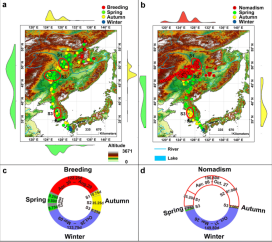The Hooded Crane (Grus monacha) is listed as a vulnerable species by IUCN. Knowledge about the migration of the Hooded Crane is still limited. Here we reported the spatio-temporal migration patterns of Hooded Cranes wintering in Izumi, Japan, as well as important stopover areas for their conservation.Four adult and five subadult cranes, all wintering in Izumi, Japan, were fitted with satellite transmitters (GPS–GSM system) at their stopover sites in northeastern China in 2014 and 2015. We analyzed the time and duration of adults and subadults in spring and autumn migration, as well as the time and duration they stayed in breeding and wintering ground. In addition, we analyzed the land use of the cranes in stopover areas.Adult cranes took much longer time to migrate both north in spring (mean?=?44.3 days) and south in fall (mean?=?54.0 days) compared with subadult cranes (15.3 and 5.2 days, respectively). However, the subadults had longer wintering (mean?=?149.8 days) and nomadic (breeding season for adults) seasons (mean?=?196.8 days) compared with adults (133.8 and 122.3 days, respectively). Three important stopover areas have been identified: the region around Muraviovka Park in Russia, the Songnen Plain in China, and the west coast of South Korea, where cranes spent most of their migration time (62.2 and 85.7% in spring and autumn, respectively). During migration, nomadic period and winter, Hooded Cranes usually stay in croplands for resting and feeding. In non-wintering season, less than 6% of stopover sites were located within protected areas.Overall, our results contribute to understanding the annual spatio-temporal migration patterns of Hooded Cranes in the eastern flyway, and planning conservation measures for this species.






